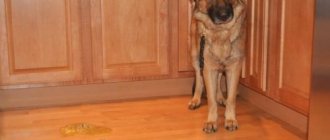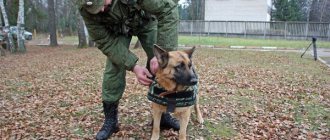Before you bring a Labrador into your apartment, weigh all the pros and cons and study the reviews of the owners. This is a kind, smart and very active breed of dog. The best place for her to live would be a private house. In urban conditions, considerable participation of the owner will be required to ensure a full life for the dog.
Consider whether you can give your pet enough attention. After all, this is not a decorative toy, but a dog with a serious hunting past. Training and energetic play will take up a lot of time in your regular schedule.
What does a pet need?
If we talk about keeping a Labrador in an apartment, it should be noted that there are pros and cons.
These dogs have a friendly disposition, so they get along very well with other pets.
The owner’s task is to take long and frequent walks and organize games.
If you comply with all these requirements, then harmony and mutual understanding will appear.
Care, love and care - this is exactly what a pet needs that will live in an apartment.
Labrador dogs are very attached to their owner, so they never abandon him.
You can always count on the fact that a person has a faithful comrade who will always save him from any danger.
It is not difficult to keep a dog in an apartment; it usually sleeps next to the owner’s bed. It cannot be kept in an enclosure or on a chain. Otherwise, she will run wild and lose her individuality.
The history of the appearance of Labradors
The history of the breed begins in 1494 on the island of Newfoundland (territory of modern Canada).
Local residents were mainly engaged in fishing and hunting, and the dogs that lived with them retrieved game from the water. Two types of dogs - with thick short hair and a long wavy mane - are called retrievers, which comes from the English to retrieve - to search for and bring prey. The main part of the entire population were short-haired Labradors .
They appeared in Foggy Albion in the 30s and 40s of the 19th century , and immediately gained great popularity thanks to positive reviews of their hunting skills. But in 1885, the import of Labradors was stopped, and selection continued only with previously imported animals.
In 1903, the Labrador breed was recognized by the Kennel Club and given its official name. The centenary of the breed in 2003 was celebrated on a grand scale. The largest dog show received more than 1 thousand participants.
Labradors often become service dogs. They are often in demand in the following areas:
- Guides for visually impaired people.
- Mountain rescuers.
- In search of narcotic and explosive compounds.
- Help various rescue services.
Labradors are also capable of working on long journeys in a harness. But the main advantage of these dog breeds is their character. These are magnificent, devoted friends , favorites of all family members.
They participate in all aspects of their owners' lives, not only in hunting. The dogs are completely devoid of aggression and get along well with children. Reviews from owners indicate that Labradors are characterized by boundless devotion to their owners.
Character and behavior of Labradors
Labrador is an active dog that expects one hundred percent attention from its owner, long walks and attentive treatment. Dogs have great patience and endurance .
Labradors get along well with children, do not show aggression, are very friendly and flexible . Such a dog can be left without fear in a room with a small child, without fear that he will harm him. Owner reviews prove that children and Labradors can become best friends.
Labradors get along well with almost all pets. Some difficulties can arise only with birds, since the hunting instinct in dogs is quite developed.
Dogs can become very sad when they are alone for a long time; they get bored without their owners in a locked apartment. But when they meet, they unleash such a flow of joy and happiness that it is impossible to remain indifferent. Playful, optimistic, Labradors make wonderful allies and loyal friends.
Master's Code
If the animal is not properly maintained and there is no upbringing, even the best puppy, which was born to purebred parents with a high title, can be ruined.
To do this, you need to familiarize yourself with the rules of the host code:
- a dog is not a toy, you need to take responsibility for it, take care of its health and behavior;
- the animal will grow up the way it is raised;
- the punishment must be in moderation and to the point;
- for successful upbringing one should show affection, consistency and patience;
- it is necessary to carry out training starting with simple tasks and gradually approaching more complex ones;
- good nutrition with good quality and fresh foods;
- walks;
- periodic examination by a veterinarian;
- vaccinations.
If you follow all these rules, you can only talk about the advantages of keeping a Labrador at home.
Before getting a puppy, you need to properly prepare for this.
You need to understand that it is necessary to remove all things that he can chew or spoil.
First of all, this applies to household appliances and wires.
Possibility of being kept outdoors
Experienced dog breeders and veterinarians unanimously say that keeping a Labrador on the street is absolutely not harmful.
The breed is able to adapt even to severe cold or unbearable heat. For information. Breeders still recommend placing your pet in a house, since without attention and affection the dog will simply waste away.
If there is no other option and it has been decided to organize a home for your pet in the private sector, that is, in the yard, it is very important to take care of the dog constantly and give it maximum attention. It is strictly forbidden to move a dog from home to street or vice versa. These manipulations will cause stress in the dog and may even lead to illness.
Many people are interested in how to care for a Labrador if he lives on the street. First of all, it is important to understand that this dog is not suitable for being kept on a chain. The best option is a spacious enclosure with an insulated booth.
Being kept on chains has a negative impact on the psyche
How to accustom to a home environment
Babies may not initially be clean, which is a clear disadvantage of keeping them. Therefore, it is necessary to remove carpeting for a while.
Initially, you can use the playpen. But the dog should not be allowed to spend all his time there. There will be no cruelty in such a restriction - these are completely acceptable educational measures.
But whenever possible, kids should run, play and frolic. Anything that is dangerous must be removed from reach.
To keep a Labrador at home, you need to be patient . After all, we are talking about the energy of the animal and its constant tricks.
Sometimes this behavior is even tiring, but the owner’s task is to make his character more acceptable.
The puppy can be taken home only after it can feed itself.
Initially, he needs to be fed 5-6 times a day, then the number of feedings is gradually reduced.
Therefore, you need to rely on someone to do this. Otherwise, certain problems with the pet's health will appear.
Advantages and disadvantages
It should be noted that keeping such a large dog in an apartment has certain disadvantages :
- organizing walks and training, which takes a lot of time;
- the dog is the source of infection;
- hygienic reasons, since the dog has long hair;
- You will have to devote a lot of time to education.
If the owner loves pets and is ready for all difficulties, this will not be a big obstacle.
Besides, having such a friend has many advantages.:
- walking a dog, a person himself has a good opportunity to breathe fresh air;
- positive emotions;
- having a loyal friend who is always ready to help;
- the kindness and responsiveness of the animal;
- friendliness;
- activity;
- devotion;
- ideal companion;
- Labrador does not bark without a reason.
Characteristics of the breed
By international standards, the average life expectancy of Labradors is 10-13 years. According to reviews from owners, these are strong dogs with a wide chest, a flat back, powerful paws and a developed neck .
A large head with a wide skull looks massive, a rather sharp transition from the nose to the forehead, friendly brown (with a hazel tint) eyes, drooping ears set far apart, a thick tail tapering to the tip, with coarse hair. In all movements of the Labrador there is power and strength, scope and grandeur.
The color of these animals can be of three types:
- pale yellow;
- brown;
- black.
The fawn color includes all varieties from light cream to red.
Rules of care and training
Labradors do not require special care.
The coat should be combed with a rubber brush to remove excess hair and massage the skin, which is necessary for proper blood circulation. Most often, dogs really like this procedure. For washing, regular clean water and combing are suitable. There is no need to use special shampoos. After bathing, you need to wipe the coat dry . These dogs are very prone to obesity and therefore special attention should be paid to nutrition.
Overcoming your natural pity, you should not indulge all the dog’s whims. The menu must be balanced and the quantity clearly limited. An adult dog needs two meals a day . You can feed both dry food and natural products (meat, cereals, dairy products).
Special training of Labradors is required in cases where participation in exhibitions, hunting and other official events is planned. For home use, standard sets of commands and orders are quite sufficient. Dogs are very easy to train and obey their owners.
Training
In order to evaluate only the positive aspects of keeping this breed at home, it is necessary to constantly train it and pay a lot of attention to it.
The dog must get used to the conditions of society, then its behavior will not become a problem.
A professional instructor will always give good recommendations on keeping a Labrador in any conditions.
There is nothing difficult about this, since this breed is easy to train and happily learns new commands.
These dogs take a long time to mature, so you need to be patient . The psychological age of maturation occurs at three years of age. Before this, they can play pranks and misbehave.
They need quite a lot of physical activity, otherwise they will get bored and look for another kind of activity for the purpose of entertainment.
They can chew furniture, peel off wallpaper or tear things. To avoid this, you need to devote at least two hours a day to walks.
This breed strives to communicate with everyone, but our world is not always ready to reciprocate. Therefore, you need to cultivate moderation in your friend’s character so that he does not impose himself on strangers.
The dog will not knowingly harm the child, but may be careless during play. Therefore, it is better not to leave small children unattended, because the dog is quite large.
Possible diseases
If the owner decides to have this animal at home, he must be prepared for the fact that it may get sick.
The most common health problems they experience are::
- food allergies;
- osteochondrosis;
- dysplasia;
- eye diseases;
- paraproctitis.
Self-medication is not recommended; you should always contact a qualified specialist.
When caring for a puppy, you should feed it on time, always caress it, take it for walks and teach it to obey commands. General care for dog lovers is not difficult. You should periodically examine the ears and eyes, comb them, and bathe them.
Where to begin
The first few days of having a puppy in your home can be tolerable. This is due to the fact that puppies miss their mothers and brothers and sisters.
During this period, you cannot leave them alone; you need to be prepared for sleepless nights. This applies not only to the Labrador breed.
You need to play with the dog, offer toys, tasty bones or tree branches. You should hold the animal in your hands confidently and firmly enough, but do not lift it unless necessary.
If the apartment has slippery floors, the animal may suffer from improper paw positioning.
Therefore, after eight months, the floor should be covered with a pile covering. Puppies cannot be locked in a dark place; for this reason, their psyche becomes upset, rickets may appear, and bones and muscle tissue develop incorrectly.
At two months, puppies love to bite, they need to be weaned off this, but in moderation in everything. Otherwise the dog will grow up cowardly.
From childhood, a Labrador should be accustomed to its place . It shouldn't be on the aisle. It is best if it is away from drafts and heating appliances.
This breed likes to sleep on an elevated position, so a chair or something similar can be used. If the dog doesn't like it, you need to find a reason for it.
Sometimes they choose their own cozy place. This way the animal will feel safe and can rest there. There is no need to feed, treat or punish in this place.
Puppy diet
Caring for a Labrador requires proper organization of feeding from childhood. Puppies are given ready-made industrial food aimed at this age group (Akana, Brit Care brands). From natural food it is permissible to offer the following products:
- lean meat;
- boiled sea fish (boneless fillet);
- dairy products;
- cereals (rolled oats, buckwheat, rice);
- eggs (1 per week).
Note! Each product is introduced into the diet carefully; the baby’s well-being must be monitored.
How to teach cleanliness
Labrador retrievers should be taught to be clean from the very first days. This will require a lot of strength and patience, but in general the animal is understanding and loves praise.
You need to choose a suitable place for the toilet; a tray with a low edge is suitable for this.
Puppies usually go to the toilet after changing their activities. This could be sleeping, playing or eating.
You can only walk outside with a vaccinated puppy . Therefore, you need to take care of comprehensive vaccination.
The first walk can be stressful, but this is not a reason to keep your dog indoors all the time. Be sure to use a leash and collar, then the animal will not run away.
When using the elevator, you should be careful that the puppy does not end up on the other side of the doors. Initially, walks will be just an excursion, an acquaintance with an unknown world.
At first, you need to walk outside for no more than twenty minutes, then the time can be gradually increased.
By six months, the puppy may be exposed to long periods of walking and jumping over obstacles.
It is not necessary to keep him on a leash all the time, but then you should choose a suitable place to play. There is no need to allow long descents from the stairs.
Then all the limbs will be correctly positioned and the spine will be straight, which is very important for dogs of this breed.
Adult dog diet
Nutrition and care for your Labrador are very important. An adult dog is fed either natural food or ready-made dry food. Two meals a day are expected at certain times, since discipline is very important for representatives of the breed.
Animals are very energetic, so they should be provided with a sufficient amount of protein food to be active. The diet includes offal, as well as greens and boiled vegetables.
It is very important to feed your dog properly
Owner's vigilance
For your pet, you need to find friends who will be his peers.
Swimming and playing with a ball will be useful. But you don’t need to force him to do something he doesn’t like.
You can come up with a lot of other, no less interesting options.
To wear down the nails, the dog should be walked on asphalt. In places where there is traffic, the animal must remain on a leash .
To prevent ticks or insects from clinging to your pet, its fur can be treated with special products. This is especially important in the warm season.
Today, aerosols, collars, and drops are provided for this. Puppies of this breed need to be shown affection and care, then they will grow up to be good helpers and loyal friends.
You need to praise or scold them only at the moment when the act was committed.
Otherwise, he will not understand why he is being punished. One of the most important commands is “no”, “place” and “sit”.
Young dogs should be trained for no more than ten minutes twice a day. You always need to achieve the execution of the command and not stop halfway.
They should not be allowed to growl at themselves and other family members. The puppy must understand that next to its owner it will always feel good, nourished, caressed and fed.
If you give your heart to dogs, they will definitely reciprocate. They only need a warm voice, hearty food and kind eyes.
What to feed?
The Labrador is an omnivorous dog and eats everything the same as its owner, but there will be little benefit from such feeding, because the dog needs complete and regular nutrition. The pet's body must receive the required amount of proteins, fats, carbohydrates and vitamins in the correct proportions every day.
If you want to feed your dog dry food , seek an opinion from a specialist ; often the composition of such food is balanced and does not require additional additives or minerals, but you can prepare treats with your own hands.
The number of feedings for a puppy is from 4 to 6 per day , food intake for an adult Labrador at home, veterinarians recommend reducing it to twice a day.
Important! The diet should include: meat, fish, cereals, dairy products, vegetables.
There are established proportions for feeding a Labrador retriever; everyone can calculate for themselves how much of certain foods are needed for their pet.
For 1 kilogram of Labrador retriever weight you need:
- 15 grams of meat;
- 5 grams of carbohydrates;
- 1 gram of fat.
The meat is suitable both boiled and raw , it all depends on the dog’s tastes. Use beef, chicken, turkey or lamb. You can boil the stomach; it contains many useful amino acids and minerals. It is better not to give bones to your dog.
Fish is also suitable both raw and boiled . Before serving the product, do not forget to remove the bones. Choose sea and lean fish.
Cereals are a source of carbohydrates and will be an excellent side dish for your pet. Do not give your Labrador oatmeal or pearl barley. Barley is poorly absorbed by the body, and oatmeal can become an allergen.
Vegetables : potatoes, zucchini, carrots and other vegetables can be cut or grated and added to the porridge.
Unlike humans, a dog does not need to add a lot of salt to its food ; a small pinch is enough.
Important! Well, the most important thing is water. Your Labrador should always have fresh, clean water in his bowl. Don't forget to change it regularly.
Table of height and weight of Labrador by month
| Age, months | Weight, kg | Height at withers, cm. | Chest circumference, cm. | Head circumference, cm. | Muzzle circumference, cm. | Muzzle length, cm. | Pastern girth, cm |
| 1 | 3.4-3.8 | 23-23.5 | 37-38 | 27-28 | 17 | 3.5-4 | 9 |
| 2 | 7-8 | 30-32.5 | 45-56 | 29-32.5 | 20.5-22 | 4.5-5.5 | 10.5-11 |
| 3 | 12-14 | 39.5-42 | 51-56 | 34-36 | 23-24 | 6-7 | 11.5-12 |
| 4 | 17-19 | 44-46 | 60-64 | 38-39 | 24-26 | 7-8 | 11.5-12 |
| 5 | 21-22 | 48-51 | 66-68 | 41-42 | 25-27 | 7.5-8.5 | 11.5-12.5 |
| 6 | 24-26 | 50-55 | 67-70 | 42-43 | 27-28 | 7.5-9 | 11.5-12.5 |
| 7 | 26-28 | 52-56 | 69-74 | 43-44 | 28-29 | 7.5-9 | 11.5-13 |
| 8 | 28-30 | 54-57 | 70-76 | 45-46 | 28-30 | 7.5-9 | 11.5-13 |
| 9 | 29-32 | 54-58 | 70-77 | 46-48 | 28-31 | 7.5-9.5 | 11.5-13.5 |
| 10 | 30-36 | 54-58 | 70-84 | 46-55 | 28-32 | 7.5-10 | 11.5-14 |
| Adult | 30-40 | 54-58 | 70-86 | 46-56 | 28-32 | 7.5-10 | 11.5-14 |
Height at the withers of Golden Retrievers: for males - 56-61 cm, for females - 51-56 cm.
It is worth noting that the data given in the table is approximate. All dogs are different, some grow up to a year, others up to 6 months, below are the average parameters for the ratio of height and weight.
Photo gallery
If you have taken responsibility for your four-legged friend, you need to see the matter through to the end, and do not despair when any problems arise along the way.











